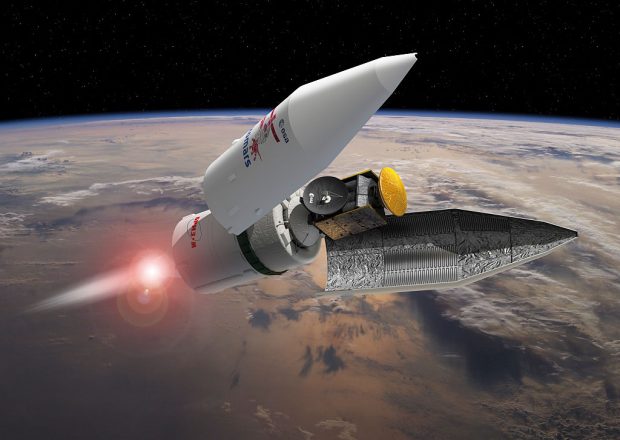If you happened to be standing today on the reddish sand of Meridiani Planum – a vast, flat, expanse just south of the Martian equator – you might well spot a dark spec in the distance against the peach-coloured sky, moving towards you. In the next few hours, the European Space Agency’s Schiaparelli probe will make its final, six-minute decent through the Martian atmosphere. If it succeeds in touching down safely, the probe will be one of the very few to make it to the Martian surface. But after a journey of 500 million kilometres, it’s only then that the probe’s work will really start: scientists hope the Schiaparelli lander will act as a Martian weather station, sending data all the way back to earth in preparation for a future, more ambitious probe.
The Schiaparelli won’t be alone on the surface of Mars: fourteen probes – some wrecked – litter the Martian landscape. Two – the US built Curiosity and Opportunity – are still working. Opportunity has been roving the surface since January 2004 and is only about 42 kilometres from the Schiaparelli lander, but the two will never meet. In the future, nine orbiters could crash onto Mars after their missions end. Still, it seems, the allure of Mars remains strong.
No planet has embedded itself into our culture as deeply as Mars has. To our ancestors, it became a fire star in the sky, to the ancient Egyptians, it was Horus the red; to other, it was the blushing star. But for many, Mars looked simply like a drop of blood in the sky. The red planet was war and ruin, pain and death. To Victorian astronomers, it seemed obvious that it was another kind of earth. With an atmosphere and markings on its surface, including what appeared to be polar ice caps, and a ‘day’ that was only 41 minutes longer than ours, it wasn’t surprising that humans wanted to try and contact Mars. Some suggested trying to signal to the Martians; another proposal was to plant trees in the desert in the shape of a right-angled triangle, in a bid to reach out across a 35 million mile gulf.
These were improbable aspirations. But in September 1877, things became a lot more serious. Mars was bright in the sky and a little closer than usual. Observers all over the world strained to get a good look at it. One of them, Giovanni Schiaparelli, with his eyes working at their limits, spotted linear structures on Mars. He called them canali – channels in Italian. This soon became mistranslated as canals, artificial ones. He saw streaks on Venus and Mercury as well. All of them phantasms. Also watching Mars that year was the wealthy American Percival Lowell. It wasn’t long before he became obsessed by the canals and with them the possibility of life on Mars. Lowell thought an ancient, dying civilisation could have built the canals to carry water from the polar caps to irrigate the deserts. He went on to map 437 of them. Most astronomers thought they were illusory but Lowell persisted. When he died he was buried next to his observatory on a place he named Mars Hill.
Martians quickly became an obsession. With the advent of radio, the US Army ordered periods of silence so they could listen out for the Martians. Nicola Tesla thought he had picked up messages from Mars. Edgar Rice Burroughs made a fortune writing about ‘Barsoom’, with its princesses, warlords, and chessmen on Mars. It was a world of romance and danger. Yet it wasn’t until 1965, when Mariner 4 flew past the red planet, that we saw the first images of Mars up close: there were no canals. Instead, Mars was a cratered and seemingly dead world.
But still the theory that there is life on Mars won’t go away. The modern view is that the probes of the last 40 years give hope for microbial life on Mars. Some say this life started when Mars was young and a lot like Earth. When Mars froze over, these tiny fragments of life clung to life. They stayed alive, some believe, when the Red Planet soon became exposed to the furious wrath of the Sun, whose solar wind stripped it of most of the remnants of its atmosphere and whose radiation sterilised its surface. Deep underground or under rocks, the theory goes, life is still there. People point to peculiar chemistry and structures found in rocks blasted from Mars that have found their way to earth to prove their point. Maybe, just maybe. But there is no Barsoom, no abandoned cities or long dead canal builders, and the chances of anything coming from Mars are not a million to one but far, far less.
No nation has got to grips with a manned Mars mission. It has always been decades in the future. If we can’t be bothered to return to the Moon, what hope is there for Mars which is much, much further away? Some billionaires have plans. Elon Musk recently spoke of settling the red planet, a million homesteaders in 40 years he says. History is against him, which is probably just the way he likes it. Mars does that to people. This ancient world with a new beginning grips them and makes them see it as a world like the Earth. That’s a mistake. Its like Mars, all Mars, all alien.
And will the Schiaparelli lander be part of a series of surface probes that could find life? We are still in the position of the astronomer who a hundred years ago was asked by a newspaper editor for 500 words about the possibility of life on Mars. He replied, nobody knows, 250 times.
Dr David Whitehouse is a writer and astronomer. He can be found on Twitter @dr_david_w






Comments